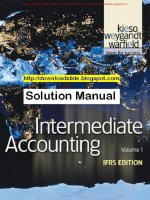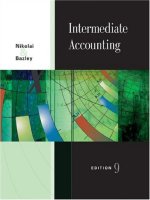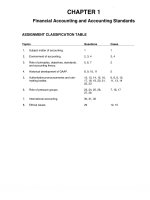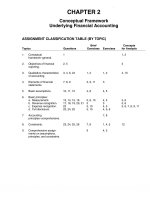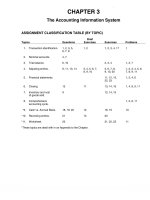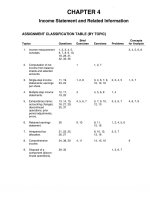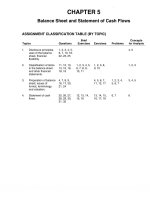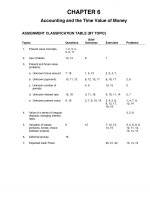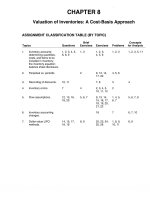Solution manual intermediate accounting IFRS volume 1 kiesoch17
Bạn đang xem bản rút gọn của tài liệu. Xem và tải ngay bản đầy đủ của tài liệu tại đây (1.2 MB, 79 trang )
To download more slides, ebook, solutions and test bank, visit
CHAPTER 17
Investments
ASSIGNMENT CLASSIFICATION TABLE (BY TOPIC)
Topics
Questions
1. Debt investments.
Brief
Exercises Exercises
1, 2, 3, 13
Problems
1
Concepts
for Analysis
4, 7
(a) Held-for-collection.
4, 5, 6, 8,
11, 13
1, 3, 10
2, 3, 4
1, 2, 7
1, 4
(b) Trading.
2, 4, 7, 8,
9, 22
2, 4
5
1, 3, 4, 7
1, 4
2. Bond amortization.
6, 7
1, 2, 3
3, 4, 5
1, 2
3. Equity investments.
1, 12, 17
1
4, 7
(a) Non-trading.
16, 22
7, 8
8, 10, 11
5, 6, 8, 9,
10, 12
(b) Trading.
8, 9, 14,
15, 16, 22
6
8, 9, 11,
12, 13, 15,
16, 17
3, 5, 6, 8, 9, 1, 2, 3
10, 11
(c)
17, 18, 19,
20, 21
9
13, 14,
17, 18
8
10, 11
5, 8, 9, 10,
11, 12
2, 7
Equity method.
4. Disclosures of investments.
22
5. Fair value option.
10, 11, 25
5
6, 7
6. Impairments.
23, 27
10
19, 20
7. Transfers between
categories.
24
11
8. Comprehensive income.
29
12
*9. Derivatives.
30, 31, 32, 33,
34, 35, 36, 37
3
5, 6
1, 3
1, 3, 7
21
12
22, 23, 24,
25, 26, 27
13, 14, 15,
16, 17, 18
*This material is dealt with in an Appendix to the chapter.
Copyright © 2011 John Wiley & Sons, Inc.
Kieso Intermediate: IFRS Edition, Solutions Manual
17-1
To download more slides, ebook, solutions and test bank, visit
ASSIGNMENT CLASSIFICATION TABLE (BY LEARNING OBJECTIVE)
Brief
Exercises
Learning Objectives
Exercises
Problems
1.
Describe the accounting framework for
financial assets.
2.
Understand the accounting for debt
investments at amortized cost.
1, 2, 3
2, 3, 4
1, 2, 7
3.
Understand the accounting for debt
investments at fair value.
2, 4
1, 5,
1, 3, 4, 7
4.
Describe the accounting for the fair value
option.
5
6, 7
2, 7, 10,
5.
Understand the accounting for equity
investments at fair value.
6, 7, 8, 12
8, 9, 10, 11,
12, 13, 15,
16, 17,
3, 5, 8, 9,
10, 11, 12
6.
Explain the equity method of accounting and
compare it to the fair value method for equity
securities.
9
13, 14, 17, 18
6, 8
7.
Discuss the accounting for impairments
of debt investments.
10
19, 20
8.
Describe the accounting for transfer of
investments between categories.
11
*9.
1
Explain why companies report reclassification
adjustments.
21
12
*10.
Explain who uses derivatives and why.
*11.
Understand the basic guidelines for
accounting for derivatives.
*12.
Describe the accounting for derivative
financial instruments.
22, 26
13, 14, 15
*13.
Explain how to account for a fair value hedge.
23, 25
16, 18
*14.
Explain how to account for a cash flow hedge.
24, 27
17
17-2
Copyright © 2011 John Wiley & Sons, Inc.
Kieso Intermediate: IFRS Edition, Solutions Manual
To download more slides, ebook, solutions and test bank, visit
ASSIGNMENT CHARACTERISTICS TABLE
Item
E17-1
E17-2
E17-3
E17-4
E17-5
E17-6
E17-7
E17-8
E17-9
E17-10
E17-11
E17-12
E17-13
E17-14
E17-15
E17-16
E17-17
E17-18
E17-19
E17-20
E17-21
*E17-22
*E17-23
*E17-24
*E17-25
*E17-26
*E17-27
P17-1
P17-2
P17-3
P17-4
P17-5
P17-6
P17-7
P17-8
P17-9
Level of
Difficulty
Time
(minutes)
Investment classifications.
Debt investments.
Debt investments.
Debt investments.
Debt investments.
Fair value option.
Fair value option.
Entries for equity investments.
Equity investments.
Equity investment entries and reporting.
Equity investment entries and financial statement
presentation.
Equity investment entries.
Journal entries for fair value and equity methods.
Equity method.
Equity investments—trading.
Equity investments—trading.
Fair value and equity method compared.
Equity method.
Impairment.
Impairment.
Comprehensive income disclosure.
Derivative transaction.
Fair value hedge.
Cash flow hedge.
Fair value hedge.
Call option.
Cash flow hedge.
Simple
Simple
Simple
Simple
Simple
Simple
Moderate
Simple
Simple
Simple
Simple
5–10
10–15
15–20
10–15
10–15
5–10
15–20
10–15
10–15
5–10
10–15
Simple
Simple
Moderate
Moderate
Moderate
Simple
Simple
Moderate
Moderate
Moderate
Moderate
Moderate
Moderate
Moderate
Moderate
Moderate
20–25
15–20
10–15
10–15
15–20
15–20
10–15
15–20
10–15
20–25
15–20
20–25
20–25
15–20
20–25
25–30
Debt investments.
Debt investments, fair value option.
Debt and equity investments.
Debt investments.
Equity investment entries and disclosures.
Equity investments.
Debt investment entries.
Fair value and equity methods.
Financial statement presentation of equity investments.
Moderate
Moderate
Moderate
Moderate
Moderate
Simple
Moderate
Moderate
Moderate
20–30
30–40
25–30
25–35
25–35
25–35
25–35
20–30
20–30
Description
Copyright © 2011 John Wiley & Sons, Inc.
Kieso Intermediate: IFRS Edition, Solutions Manual
17-3
To download more slides, ebook, solutions and test bank, visit
ASSIGNMENT CHARACTERISTICS TABLE (Continued)
Item
P17-10
P17-11
P17-12
*P17-13
*P17-14
*P17-15
*P17-16
*P17-17
*P17-18
CA17-1
CA17-2
CA17-3
CA17-4
CA17-5
CA17-6
CA17-7
17-4
Description
Equity investments.
Investments—statement presentation.
Gain on sale of investments and comprehensive income.
Derivative financial instrument.
Derivative financial instrument.
Free-standing derivative.
Fair value hedge interest rate swap.
Cash flow hedge.
Fair value hedge.
Level of
Difficulty
Complex
Moderate
Moderate
Moderate
Moderate
Moderate
Moderate
Moderate
Moderate
Time
(minutes)
30–40
20–30
20–30
20–25
20–25
20–25
30–40
25–35
25–35
Issues raised about investments.
Equity investments.
Financial statement effect of investments.
Equity investments.
Investment accounted for under the equity method.
Equity investments.
Fair value—ethics.
Moderate
Moderate
Simple
Moderate
Simple
Moderate
Moderate
25–30
25–30
20–30
20–25
15–25
25–35
25–35
Copyright © 2011 John Wiley & Sons, Inc.
Kieso Intermediate: IFRS Edition, Solutions Manual
To download more slides, ebook, solutions and test bank, visit
ANSWERS TO QUESTIONS
1. The two criteria for determining the valuation of financial assets are the (1) company’s business
model for managing their financial assets and (2) contractual cash flow characteristics of the
financial asset.
2. Only debt investments such as loans and bond investments are valued at amortized cost. A
company should use amortized cost if it has a business model whose objective is to hold assets
in order to collect contractual cash flows and the contractual terms of the financial asset gives
specified dates to cash flows.
3. Amortized cost is the initial recognition amount of the investment minus repayments, plus or
minus cumulative amortization and net of any reduction for uncollectibility.
Fair value is the amount for which an asset could be exchanged between knowledgeable willing
parties in an arm’s length transaction.
4. Lady Gaga should classify this investment as a trading investment because companies frequently
buy and sell this type of investment to generate profits in short term differences in price.
5. If Lady Gaga plans to hold the investment to collect interest and receive the principal at maturity,
it should account for this investment at amortized cost.
6. $3,500,000 X 10% = $350,000; $350,000 ÷ 2 = $175,000. Wheeler would make the following entry:
Cash ($4,000,000 X 8% X 1/2) ............................................................
Debt Investments ...............................................................................
Interest Revenue ($3,500,000 X 10% X 1/2) ...................................
160,000
15,000
7. Securities Fair Value Adjustment ...............................................................
Unrealized Holding Gain or Loss—Income
[$3,604,000 – ($3,500,000 + $15,000)*] .........................................
89,000
175,000
89,000
*See number 6.
8. Unrealized holding gains and losses for trading investments should be included in net income for
the current period. Unrealized holding gains and losses are not recognized for held-for-collection
investments.
9. (a) Unrealized Holding Gain or Loss—Income.........................................
Securities Fair Value Adjustment................................................
60,000
(b) Unrealized Holding Gain or Loss—Income.........................................
Securities Fair Value Adjustment................................................
70,000
60,000
70,000
10. The fair value option allows companies the choice of reporting debt investments at fair value. If
this option is chosen, the company records in net income unrealized gains and losses with
corresponding increases/decreases to the debt investment. The unrealized gain (loss) is the
difference between the investment’s amortized cost and its fair value.
11. No, Franklin cannot use the fair value option for this investment. This option is generally available
only at the time a company first purchases the investment.
Copyright © 2011 John Wiley & Sons, Inc.
Kieso Intermediate: IFRS Edition, Solutions Manual
17-5
To download more slides, ebook, solutions and test bank, visit
Questions Chapter 17 (Continued)
12. Investments in equity securities can be classified as follows:
(a) Holdings of less than 20% (fair value method)—investor has passive interest.
(b) Holdings between 20% and 50% (equity method)—investor has significant influence.
(c) Holdings of more than 50% (consolidated statements)—investor has controlling interest.
Holdings of less than 20% are then classified into trading and non-trading, assuming determinable
fair values.
13. Investments in shares do not have a maturity date and therefore cannot be classified as held-forcollection.
14. Equity Investments ...............................................................................
Brokerage Expense ..............................................................................
Cash [(10,000 X $26) + $1,500] ....................................................
260,000
1,500
261,500
15. Gross selling price of 10,000 shares at $27.50 .....................................
Less: Brokerage commissions .............................................................
Proceeds from sale ...............................................................................
Cost of 10,000 shares...........................................................................
Gain on sale of shares ..........................................................................
Cash .....................................................................................................
Equity Investments ........................................................................
Gain on Sale of Equity Investment ................................................
$275,000
(1,770)
273,230
(260,000)
$ 13,230
273,230
260,000
13,230
16. Both trading and non-trading equity investments are reported at fair value. However, any
unrealized holding gain or loss is reported in net income for trading investments but as other
comprehensive income and as a separate component of equity for non-trading investments.
17. Significant influence over an investee may result from representation on the board of directors,
participation in policy-making processes, material intercompany transactions, interchange of
managerial personnel, or technological dependency. An investment (direct or indirect) of 20% or
more of the voting shares of an investee constitutes significant influence unless there exists
evidence to the contrary.
18. Under the equity method, the investment is originally recorded at cost, but is adjusted for
changes in the investee’s net assets. The investment account is increased (decreased) by the
investor’s proportionate share of the earnings (losses) of the investee and decreased by all
dividends received by the investor from the investee.
19. The following information is reported under the equity method:
1.
Investments originally recorded at cost with adjustment for the investor’s share of the
investee’s income or loss, and decreased by dividends received from the investee (reported
under investments.)
2.
Investment revenue is recognized equal to the investor’s ownership percentage times the
investee’s income or loss reported subsequent to the date of acquisition (reported under
other income and expense).
20. Dividends subsequent to acquisition should be accounted for as a reduction in the equity
investment account.
17-6
Copyright © 2011 John Wiley & Sons, Inc.
Kieso Intermediate: IFRS Edition, Solutions Manual
To download more slides, ebook, solutions and test bank, visit
Questions Chapter 17 (Continued)
21. Ordinarily, Raleigh Corp. should discontinue applying the equity method and not provide for
additional losses beyond the carrying value of £170,000. However, if Raleigh Corp.’s loss is not
limited to its investment (due to a guarantee of Borg’s obligations or other commitment to provide
further financial support or if imminent return to profitable operations by Borg appears to be
assured), it is appropriate for Raleigh Corp. to provide for its entire £186,000 share of the
£620,000 loss.
22. Trading equity investments are reported as a current asset while non-trading investments are
reported as a long-term investment. Trading investments are expected to be disposed of within
the coming year and therefore qualify as current assets. This is not the case for non-trading
investments which are presented under investments.
23. A debt investment is impaired when ―it is probable that the investor will be unable to collect all
amounts due according to the contractual terms.‖ When an impairment has occurred, the
investment is written down to its fair value, which is also the security’s new cost basis. The
amount of the writedown is accounted for as a realized loss.
24. When an investment is transferred from one category to another, the transfer should be recorded
at fair value, which in this case becomes the new basis for the security.
25. Major unresolved issues related to fair value accounting include measurement based on
business model, gains trading, and liabilities not fairly valued.
26. Similarities include: (1) The accounting for trading investments is the same between U.S.
GAAP and IFRS. Held-to-maturity (U.S. GAAP) and held-for-collection investments are
accounted for at amortized cost. Gains and losses related to available-for-sale securities (U.S.
GAAP) and non-trading equity investments (IFRS) are reported in other comprehensive income;
(2) U.S. GAAP and IFRS are similar in the accounting for the fair value option. That is, the
selection to use the fair value method must be made at initial recognition, the selection is
irrevocable, and gains and losses related to fair value changes are reported as part of income;
(3) Measurement of impairments is similar under U.S. GAAP and IFRS; (4) Both U.S. GAAP and
IFRS use the same tests to determine whether the equity method of accounting should be
used—that is, significant influence with a general guide of over 20 percent ownership.
Differences include: (1) U.S. GAAP and IFRS have different classifications for investments.
U.S. GAAP classifies investments as trading, available-for-sale (both debt and equity
investments), and held-to-maturity (only for debt investments). IFRS uses held-for-collection
(debt investments), trading (both debt and equity investments), and non-trading equity
investments classifications. U.S. GAAP classifications are based on management’s intent with
respect to the investment. IFRS classifications are based on the business model used to manage
the investments and the type of security; (2) Reclassifications in and out of trading securities are
allowed under U.S. GAAP if management changes its intent, but this type of reclassification
should be rare. Reclassifications of held-to-maturity investments are tightly constrained under
U.S. GAAP. IFRS allows reclassifications if the business model for managing the investments
changes. Similar to U.S. GAAP, such changes in business model should be rare; (3) The basis
for consolidation under IFRS is control. Under U.S. GAAP, a bipolar approach is used, which is a
risk-and-reward model (often referred to as a variable-entity approach) and a voting-interest
approach. However, under both systems, for consolidation to occur, the investor company must
generally own 50 percent of another company (4) U.S. GAAP allows the fair value option for
equity method investments; IFRS does not; and (5) U.S. GAAP does not permit the reversal of an
important charge related to available-for-sale debt and equity investments. IFRS allows reversals
of impairments of held-for-collection investments.
Copyright © 2011 John Wiley & Sons, Inc.
Kieso Intermediate: IFRS Edition, Solutions Manual
17-7
To download more slides, ebook, solutions and test bank, visit
Questions Chapter 17 (Continued)
27.
(a) Under U.S. GAAP, Ramirez makes no entry, because impaired investments may not be
written up if they recover in value. Under IFRS, Ramirez makes the following entry:
(b) Debt Investments .................................................................................
Recovery of Loss on Investment ....................................................
300,000
300,000
28. IFRS 9, introduced new investment classifications and increased the situations when investments
are accounted for at fair value with gains and losses recorded in income. The IASB’s decision to
issue new rules on investments before the FASB has completed its deliberations on financial
instrument accounting could affect convergence with U.S. GAAP.
*29. Reclassification adjustments are necessary to insure that double counting does not result when
realized gains or losses are reported as part of net income but also are shown as part of other
comprehensive income in the current period or in previous periods.
*30. An underlying is a special interest rate, security price, commodity price, index of prices or rates,
or other market-related variable. Changes in the underlying determine changes in the value of
the derivative. Payment is determined by the interaction of the underlying with the face amount
and the number of shares, or other units specified in the derivative contract (these elements are
referred to as notional amounts).
*31. See illustration below:
Traditional Financial Instrument
Feature
(e.g., Trading Security)
Payment Provision Share price times the number
of shares.
Initial Investment
Investor pays full cost.
Settlement
Deliver shares to receive cash.
Derivative Financial Instrument
(e.g., Call Option)
Change in share price (underlying)
times number of shares (notional
amount).
Initial investment is less than full cost.
Receive cash equivalent, based on
changes in share price times the
number of shares.
For a traditional financial instrument, an investor generally must pay the full cost, while derivatives
require little initial investment. In addition, the holder of a traditional security is exposed to all risks
of ownership, while most derivatives are not exposed to all risks associated with ownership in the
underlying. For example, the intrinsic value of a call option only can increase in value. Finally,
unlike a traditional financial instrument, the holder of a derivative could realize a profit without ever
having to take possession of the underlying. This feature is referred to as net settlement and serves
to reduce the transaction costs associated with derivatives.
*32. The purpose of a fair value hedge is to offset the exposure to changes in the fair value of a
recognized asset or liability or of an unrecognized firm commitment.
*33. The unrealized holding gain or loss on non-trading equity investments should be reported as
income when this security is designated as a hedged item in a qualifying fair value hedge. If the
hedge meets the special hedge accounting criteria (designation, documentation, and effectiveness),
the unrealized holding gain or losses is reported as income.
17-8
Copyright © 2011 John Wiley & Sons, Inc.
Kieso Intermediate: IFRS Edition, Solutions Manual
To download more slides, ebook, solutions and test bank, visit
Questions Chapter 17 (Continued)
*34. This is likely a setting where the company is hedging the fair value of a fixed-rate debt obligation.
The fixed payments received on the swap will offset fixed payments on the debt obligation. As a
result, if interest rates decline, the value of the swap contract increases (a gain), while at the
same time the fixed-rate debt obligation increases (a loss). The swap is an effective risk
management tool in this setting because its value is related to the same underlying (interest
rates) that will affect the value of the fixed-rate bond payable. Thus, if the value of the swap goes
up, it offsets the loss in the value of the debt obligation.
*35. A cash flow hedge is used to hedge exposures to cash flow risk, which is exposure to the
variability in cash flows. The cash flows received on the hedging instrument (derivative) will offset
the cash flows received on the hedged item. Generally, the hedged item is a transaction that is
planned some time in the future (an anticipated transaction).
*36. Derivatives used in cash flow hedges are accounted for at fair value on the statement of financial
position but gains or losses are recorded in equity as part of other comprehensive income.
*37. A hybrid security is a security that has characteristics of both debt and equity and often is a
combination of traditional and derivative financial instruments. A convertible bond is a hybrid
security because it is comprised of a debt security, referred to as the host security, combined
with an option to convert the bond to ordinary shares, the embedded derivative.
Copyright © 2011 John Wiley & Sons, Inc.
Kieso Intermediate: IFRS Edition, Solutions Manual
17-9
To download more slides, ebook, solutions and test bank, visit
SOLUTIONS TO BRIEF EXERCISES
BRIEF EXERCISE 17-1
(a) Debt Investments ......................................................
Cash ...................................................................
74,086
(b) Cash (€80,000 X .09)..................................................
Debt Investments ......................................................
Interest Revenue (€74,086 X .11) ......................
7,200
949
74,086
8,149
BRIEF EXERCISE 17-2
(a) Debt Investments ......................................................
Cash ...................................................................
74,086
(b) Cash (€80,000 X .09)..................................................
Debt Investments ......................................................
Interest Revenue (€74,086 X .11) ......................
7,200
949
(c) Securities Fair Value Adjustment ............................
Unrealized Holding Gain or Loss—Income
[(€74,086 + €949) – €75,500] ...........................
465
74,086
8,149
465
BRIEF EXERCISE 17-3
(a) Debt Investments ......................................................
Cash ...................................................................
65,118
(b) Cash (€60,000 X .08 x 6/12) .........................................
Debt Investments ..............................................
Interest Revenue (€65,118 X .06 x 6/12) .............
2,400
65,118
446
1,954
BRIEF EXERCISE 17-4
(a) Debt Investments ......................................................
Cash ...................................................................
50,000
(b) Cash ...........................................................................
Interest Revenue ...............................................
2,000
(c) Unrealized Holding Gain or Loss—Income .............
Securities Fair Value Adjustment
($50,000 – $47,400) ........................................
2,600
17-10
Copyright © 2011 John Wiley & Sons, Inc.
50,000
2,000
2,600
Kieso Intermediate: IFRS Edition, Solutions Manual
To download more slides, ebook, solutions and test bank, visit
BRIEF EXERCISE 17-5
Unrealized Holding Gain or Loss—Income ..................
Debt Investments [(€65,118 – €446) – €64,000] ......
672
672
BRIEF EXERCISE 17-6
(a) Equity Investments .................................................
Cash .................................................................
13,200
(b) Cash.........................................................................
Dividend Revenue (400 X £3.25).....................
1,300
(c) Securities Fair Value Adjustment ..........................
Unrealized Holding Gain or Loss—Income
[(400 X £34.50) – £13,200]............................
600
13,200
1,300
600
BRIEF EXERCISE 17-7
(a) Equity Investments .................................................
Cash .................................................................
13,200
(b) Cash.........................................................................
Dividend Revenue (400 X £3.25).....................
1,300
(c) Securities Fair Value Adjustment ..........................
Unrealized Holding Gain or Loss—
Equity [(400 X £34.50) – £13,200] ................
600
13,200
1,300
600
BRIEF EXERCISE 17-8
Securities Fair Value Adjustment
Bal.
200
500
Bal.
700
Securities Fair Value Adjustment ....................................
Unrealized Holding Gain or Loss—Equity ...............
Copyright © 2011 John Wiley & Sons, Inc.
Kieso Intermediate: IFRS Edition, Solutions Manual
500
500
17-11
To download more slides, ebook, solutions and test bank, visit
BRIEF EXERCISE 17-9
Equity Investments.........................................................
Cash .........................................................................
300,000
Equity Investments.........................................................
Revenue from Investment (30% X $180,000) .........
54,000
Cash ................................................................................
Equity Investments (30% X $60,000) .....................
18,000
300,000
54,000
18,000
BRIEF EXERCISE 17-10
Loss on Impairment ................................................
Debt Investments ............................................
10,000
10,000
In this case, an impairment has occurred and the individual security should
be written down.
BRIEF EXERCISE 17-11
Debt Investments ......................................................
Securities Fair Value Adjustment ....................
10,325
10,325
BRIEF EXERCISE 17-12
(a)
Other comprehensive income (loss) for 2011: (€20.380 million)
(b) Comprehensive income for 2011: €652.258 million or (€672.638 – €20.380)
(c)
17-12
Accumulated other comprehensive income: €16.893 million or (€37.273 –
€20.380)
Copyright © 2011 John Wiley & Sons, Inc.
Kieso Intermediate: IFRS Edition, Solutions Manual
To download more slides, ebook, solutions and test bank, visit
SOLUTIONS TO EXERCISES
EXERCISE 17-1 (5–10 minutes)
(a) 2.
(b) 4.
(c) 2.
(d) 1.
(e) 1.
(f) 4.
EXERCISE 17-2 (10–15 minutes)
(a)
January 1, 2010
Debt Investments ..............................................
Cash ...........................................................
(b)
300,000
300,000
December 31, 2010
Cash...................................................................
Interest Revenue .......................................
(c)
30,000
30,000
December 31, 2011
Cash...................................................................
Interest Revenue .......................................
30,000
30,000
EXERCISE 17-3 (15–20 minutes)
(a)
January 1, 2010
Debt Investments ..............................................
Cash ...........................................................
(b)
537,907.40
537,907.40
Schedule of Interest Revenue and Bond Premium Amortization
12% Bonds Sold to Yield 10%
Date
1/1/10
12/31/10
12/31/11
12/31/12
12/31/13
12/31/14
Cash
Received
—
$60,000
60,000
60,000
60,000
60,000
Interest
Revenue
—
$53,790.74
53,169.81
52,486.80
51,735.48
50,909.77*
Premium
Amortized
—
$6,209.26
6,830.19
7,513.20
8,264.52
*9,090.23
Carrying Amount
of Bonds
$537,907.40
531,698.14
524,867.95
517,354.75
509,090.23
500,000.00
*Rounded by 75¢.
Copyright © 2011 John Wiley & Sons, Inc.
Kieso Intermediate: IFRS Edition, Solutions Manual
17-13
To download more slides, ebook, solutions and test bank, visit
EXERCISE 17-3 (Continued)
(c)
December 31, 2010
Cash .....................................................................
Debt Investments ........................................
Interest Revenue .........................................
(d)
60,000.00
6,209.26
53,790.74
December 31, 2011
Cash .....................................................................
Debt Investments ........................................
Interest Revenue .........................................
60,000.00
6,830.19
53,169.81
EXERCISE 17-4 (10–15 minutes)
(a)
Schedule of Interest Revenue and Bond Discount Amortization
9% Bond Purchased to Yield 12%
Date
1/1/10
12/31/10
12/31/11
12/31/12
Cash
Received
—
$27,000
27,000
27,000
Interest
Bond Discount Carrying Amount
Revenue
Amortization
of Bonds
—
—
$278,384.00
$33,406.08*
$6,406.08
284,790.08
34,174.81
7,174.81
291,964.89
35,035.11**
8,035.11
300,000.00
**$278,384 X .12 = $33,406.08
**Rounded by $.68.
(b)
December 31, 2011
Cash .....................................................................
Debt Investments ................................................
Interest Revenue .........................................
27,000.00
7,174.81
34,174.81
EXERCISE 17-5 (10–15 minutes)
(a)
January 1, 2010
Debt Investments ................................................
Cash .............................................................
17-14
Copyright © 2011 John Wiley & Sons, Inc.
537,907.40
537,907.40
Kieso Intermediate: IFRS Edition, Solutions Manual
To download more slides, ebook, solutions and test bank, visit
EXERCISE 17-5 (Continued)
(b)
December 31, 2010
Cash......................................................................
Debt Investments .........................................
Interest Revenue ($537,907.40 X .10) ..........
60,000.00
Securities Fair Value Adjustment .......................
Unrealized Holding Gain or Loss—
Income ($534,200.00 – $531,698.14) ........
2,501.86
(c)
6,209.26
53,790.74
2,501.86
December 31, 2011
Unrealized Holding Gain or Loss—Income ........
Securities Fair Value Adjustment ...............
Amortized
Cost
Debt investments
Previous securities fair value
adjustment—Dr.
Securities fair value
adjustment—Cr.
12,369.81
12,369.81
Fair Value
Unrealized
Holding
Gain (Loss)
$524,867.95 $515,000.00 $ (9,867.95)
2,501.86
$(12,369.81)
EXERCISE 17-6 (5–10 minutes)
(a)
December 31, 2010
Debt Investments .................................................
Unrealized Holding Gain or Loss—
Income ($540,000 – $531,698.14)..............
Copyright © 2011 John Wiley & Sons, Inc.
8,301.86
Kieso Intermediate: IFRS Edition, Solutions Manual
8,301.86
17-15
To download more slides, ebook, solutions and test bank, visit
EXERCISE 17-6 (Continued)
(b)
December 31, 2011
Unrealized Holding Gain or Loss-Income ....
Debt Investments
($533,169.81 – $525,000) ....................
8,169.81
8,169.81
Carrying Value at 12/31/10............................. $540,000.00
Amortization ...................................................
(6,830.19) (See Exercise 17-3)
Carrying Value at 12/31/11 ..................... $533,169.81
EXERCISE 17-7 (15-20 minutes)
(a) Net income before gains and losses ........................
Investments Debt ($41,000 – $40,000) ......................
Bonds payable ($220,000 – $195,000) ......................
Net income .................................................................
(b) Bonds Payable ...........................................................
Unrealized Holding Gain or Loss-Income
($220,000 – $195,000) .....................................
$100,000
1,000
25,000
$126,000
25,000
25,000
EXERCISE 17-8 (10–15 minutes)
(a) Securities Fair Value Adjustment .............................
Unrealized Holding Gain or Loss—Income ......
3,000
(b) Securities Fair Value Adjustment .............................
Unrealized Holding Gain or Loss—Equity ........
3,000
3,000
3,000
(c) The Unrealized Holding Gain or Loss—Income account is reported in
the income statement under Other income and expense. The Unrealized
Holding Gain or Loss—Equity account is reported as a part of other
comprehensive income and as a component of equity until realized. The
Securities Fair Value Adjustment account is added to the cost of the
Equity Investments account to arrive at fair value.
17-16
Copyright © 2011 John Wiley & Sons, Inc.
Kieso Intermediate: IFRS Edition, Solutions Manual
To download more slides, ebook, solutions and test bank, visit
EXERCISE 17-9 (10–15 minutes)
(a) December 31, 2010
Unrealized Holding Gain or Loss—Income ...............
Securities Fair Value Adjustment ......................
1,400
(b) During 2011
Cash............................................................................
Loss on Sale of Equity Investment ...........................
Equity Investments ............................................
9,500
500
1,400
10,000
(c) December 31, 2011
Investments
Stargate Corp. shares
Vectorman Co. shares
Total of portfolio
Previous securities fair value
adjustment balance—Cr.
Securities fair value
adjustment—Dr.
Cost
€20,000
20,000
€40,000
Fair Value
€19,300
20,500
€39,800
Securities Fair Value Adjustment ...............................
Unrealized Holding Gain or Loss—Income .......
Unrealized
Gain (Loss)
(€ (700)
( 500)
( (200)
(
(1,400)
(€1,200)
1,200
1,200
EXERCISE 17-10 (5–10 minutes)
The unrealized gains and losses resulting from changes in the fair value of
equity investments [classified as non-trading] are recorded in an unrealized
holding gain or loss account that is reported as other comprehensive
income and as a separate component of equity until realized. Therefore, the
following adjusting entry should be made at the year-end:
Unrealized Holding Gain or Loss—Equity ...........................
Securities Fair Value Adjustment .................................
6,000
6,000
Unrealized Holding Gain or Loss—Equity is reported as other comprehensive
income and as a separate component in equity and not included in net income.
The Securities Fair Value Adjustment account is a valuation account to the
related investment account.
Copyright © 2011 John Wiley & Sons, Inc.
Kieso Intermediate: IFRS Edition, Solutions Manual
17-17
To download more slides, ebook, solutions and test bank, visit
EXERCISE 17-11 (10–15 minutes)
(a) The portfolio should be reported at the fair value of $54,500. Since the
cost of the portfolio is $53,000, the unrealized holding gain is $1,500, of
which $200 is already recognized. Therefore, the December 31, 2010
adjusting entry should be:
Securities Fair Value Adjustment .................................
Unrealized Holding Gain or Loss—Income ..........
1,300
1,300
(b) The unrealized holding gain of $1,300 should be reported as other
income and expense on the income statement and the Securities Fair
Value Adjustment account balance of $1,500 should be added to the
cost of the investment account.
WENGER, INC.
Statement of Financial Position
As of December 31, 2010
____________________________________________________________
Current assets:
Equity investment .............................................
$54,500
(c) Computation of realized gain or loss on sale of investment:
Net proceeds from sale of investment .............
Cost of investment A ........................................
Loss on sale of shares ......................................
January 20, 2011
Cash ...........................................................................
Loss on Sale of Equity Investment ..........................
Equity Investments ...........................................
(d) Securities Fair Value Adjustment ............................
Unrealized Holding Gain or Loss—Equity .......
17-18
Copyright © 2011 John Wiley & Sons, Inc.
$15,300
(17,500)
($ 2,200)
15,300
2,200
17,500
1,300
1,300
Kieso Intermediate: IFRS Edition, Solutions Manual
To download more slides, ebook, solutions and test bank, visit
EXERCISE 17-12 (20–25 minutes)
(a) The total purchase price of these investments is:
Gonzalez: (9,000 X $33.50) = $301,500
Belmont: (5,000 X $52.00) = $260,000
Thep:
(7,000 X $26.50) = $185,500
The purchase entries will be:
January 15, 2011
Commission Expense ..........................................
Equity Investments ...............................................
Cash ...............................................................
1,980
301,500
303,480
April 1, 2011
Commission Expense ..........................................
Equity Investments ...............................................
Cash ...............................................................
3,370
260,000
263,370
September 10, 2011
Commission Expense ..........................................
Equity Investments ...............................................
Cash ...............................................................
4,910
185,500
190,410
(b) Gross selling price of 3,000 shares at $35 ..........
Less: Commissions, taxes, and fees .................
Net proceeds from sale ........................................
Cost of 3,000 shares ($301,500 X 3/9) .................
Gain on sale of shares .........................................
$105,000
(2,850)
102,150
(100,500)
$ 1,650
May 20, 2010
Cash.......................................................................
Equity Investment .........................................
Gain on Sale of Equity Investment ..............
Copyright © 2011 John Wiley & Sons, Inc.
102,150
Kieso Intermediate: IFRS Edition, Solutions Manual
100,500
1,650
17-19
To download more slides, ebook, solutions and test bank, visit
EXERCISE 17-12 (Continued)
(c)
Investments
Gonzalez Co.
Belmont Co.
Thep Co.
Total portfolio value
Previous securities fair value
adjustment balance
Securities fair value
adjustment—Dr.
Cost
Fair Value
$201,000* $180,000(1)
260,000
275,000(2)
185,500
196,000(3)
$646,500 $651,000
Unrealized
Gain (Loss)
$(21,000)
(15,000
10,500
4,500
0
$ 4,500
*$301,500 X 6/9 = $201,000.
(1)
(2)
(6,000 X $30)
(5,000 X $55)
(3)
(7,000 X $28)
December 31, 2010
Securities Fair Value Adjustment .........................
Unrealized Holding Gain or Loss—Income ..
4,500
4,500
EXERCISE 17-13 (15–20 minutes)
Situation 1: Journal entries by Hatcher Cosmetics:
To record purchase of 20,000 shares of Ramirez Fashion at a cost of
$14 per share:
March 18, 2010
Equity Investments........................................................
Cash ........................................................................
280,000
280,000
To record the dividend revenue from Ramirez Fashion:
June 30, 2010
Cash ...............................................................................
Dividend Revenue ($75,000 X 10%) ......................
17-20
Copyright © 2011 John Wiley & Sons, Inc.
7,500
7,500
Kieso Intermediate: IFRS Edition, Solutions Manual
To download more slides, ebook, solutions and test bank, visit
EXERCISE 17-13 (Continued)
To record the investment at fair value:
December 31, 2010
Securities Fair Value Adjustment.....................................
Unrealized Holding Gain or Loss—Income ..............
20,000
20,000*
*($15 – $14) X 20,000 shares = $20,000
Situation 2: Journal entries by Holmes, Inc.:
To record the purchase of 25% of Nadal Corporation’s ordinary shares:
January 1, 2010
Equity Investments ...........................................................
Cash [(30,000 X 25%) X $9] .......................................
67,500
67,500
Since Holmes, Inc. obtained significant influence over Nadal Corp.,
Holmes, Inc. now employs the equity method of accounting.
To record the receipt of cash dividends from Nadal Corporation:
June 15, 2010
Cash ($36,000 X 25%) ........................................................
Equity Investments ....................................................
9,000
9,000
To record Holmes’s share (25%) of Nadal Corporation’s net income of $85,000:
December 31, 2010
Equity Investments (25% X $85,000) ................................
Revenue from Investment .........................................
Copyright © 2011 John Wiley & Sons, Inc.
Kieso Intermediate: IFRS Edition, Solutions Manual
21,250
21,250
17-21
To download more slides, ebook, solutions and test bank, visit
EXERCISE 17-14 (10–15 minutes)
(a)
$130,000, the increase to the Investment account.
(b)
If the dividend payout ratio is 40%, then 40% of the net income is their
share of dividends = $52,000. The answer is also given in the T-account
information.
(c)
Their share is 25%, so, Total Net Income X 25% = $130,000
Total Net Income = $130,000 ÷ 25% = $520,000
(d)
$52,000 ÷ 25% = $208,000 or $520,000 X 40% = $208,000
EXERCISE 17-15 (10–15 minutes)
1.
2.
3.
Equity Investments (300 shares X $40) ..................
Cash .............................................................
12,000
Cash (100 shares X $43) .........................................
Gain on Sale of Equity Investment ............
Equity Investments (100 X $40) .................
4,300
Unrealized Holding Gain or Loss—Income ...........
Securities Fair Value Adjustment
($40 – $35) X 200 ......................................
1,000
12,000
300
4,000
1,000
EXERCISE 17-16 (15–20 minutes)
(a) Unrealized Holding Gain or Loss—Income .............
Securities Fair Value Adjustment .....................
5,900
(b) Cash [(1,500 X £45) – £1,200] ...................................
Loss on Sale of Equity Investment ..........................
Equity Investments ...........................................
66,300
5,200
(c) Brokerage Expense ..................................................
Equity Investments (700 X £75)................................
Cash ...................................................................
1,300
52,500
17-22
Copyright © 2011 John Wiley & Sons, Inc.
5,900
71,500
53,800
Kieso Intermediate: IFRS Edition, Solutions Manual
To download more slides, ebook, solutions and test bank, visit
EXERCISE 17-16 (Continued)
(d)
Investments
Beilman Corp., Ordinary
McDowell Corp., Ordinary
Duncan, Inc., Preference
Total portfolio
Previous securities fair value
adjustment—Cr.
Securities fair value adjustment—Cr.
Cost
£180,000
52,500
60,000
£292,500
Unrealized Holding Gain or Loss—
Income ...........................................................
Securities Fair Value Adjustment ............
Fair Value
£175,000
50,400
58,000
£283,400
Unrealized
Holding Gain
(Loss)
£(5,000)
(2,100)
(2,000)
(9,100)
(5,900)
£(3,200)
3,200
3,200
EXERCISE 17-17 (15–20 minutes)
(a)
December 31, 2010
Equity Investments ........................................... 125,000,000
Cash ...........................................................
125,000,000
June 30, 2011
Cash...................................................................
Dividend Revenue (50,000 X ¥80) .............
4,000,000
4,000,000
December 31, 2011
Cash...................................................................
Dividend Revenue (50,000 X ¥80) .............
4,000,000
Securities Fair Value Adjustment .................... 10,000,000
Unrealized Holding Gain or Loss—
Income ...................................................
¥2,700 X 50,000 = ¥135,000,000
¥135,000,000 – ¥125,000,000 = ¥10,000,000
Copyright © 2011 John Wiley & Sons, Inc.
Kieso Intermediate: IFRS Edition, Solutions Manual
4,000,000
10,000,000
17-23
To download more slides, ebook, solutions and test bank, visit
EXERCISE 17-17 (Continued)
(b)
December 31, 2010
Equity Investments ............................................ 125,000,000
Cash ............................................................
125,000,000
June 30, 2011
Cash ....................................................................
Equity Investments ....................................
4,000,000
4,000,000
December 31, 2011
Cash ....................................................................
Equity Investments ....................................
4,000,000
Equity Investments ............................................
Revenue from Investment
(20% X ¥73,000,000) ...............................
14,600,000
(c)
4,000,000
14,600,000
Fair Value
Method
Investment amount (statement of
financial position)
Dividend revenue (income statement)
Unrealized holding gain
(income statement)
Revenue from investment
(income statement)
Equity Method
¥135,000,000 *¥131,600,000*
8,000,000
0
10,000,000
14,600,000
*¥125,000,000 + ¥14,600,000 – ¥4,000,000 – ¥4,000,000
EXERCISE 17-18 (10–15 minutes)
17-24
Equity Investments ..................................................
Cash ..................................................................
200,000
Cash (£20,000 X .25) ................................................
Equity Investments ..........................................
5,000
Equity Investments ..................................................
Revenue from Investment (.25 X £80,000) ......
20,000
Copyright © 2011 John Wiley & Sons, Inc.
200,000
5,000
20,000
Kieso Intermediate: IFRS Edition, Solutions Manual
To download more slides, ebook, solutions and test bank, visit
EXERCISE 17-19 (15–20 minutes)
(a) The entry to record the impairment is as follows:
Loss on Impairment ($800,000 – $740,000) ...........
Debt Investments ............................................
60,000
60,000
(b) The new cost basis is $740,000. If the bonds are impaired, it is inappropriate to increase (amortize) the asset back up to its original maturity
value.
(c) Debt Investments ....................................................
Recovery of Impairment Loss
($760,000 – $740,000) ...................................
20,000
20,000
EXERCISE 17-20 (10–15 minutes)
(a) Contractual cash flow
[(€400,000 X .10 X 3) + €400,000] .........................
Expected cash flow ................................................
Cash flow loss ........................................................
Recorded investment .............................................
Less: Present value of €350,000 due in
3 years at 10% (€350,000 X .75131) .....................
Present value of €35,000 annual interest
for 3 years at 10% (€35,000 X 2.48685) ...............
Impairment loss ......................................................
(b) Loss on Impairment ................................................
Debt Investment ..............................................
Copyright © 2011 John Wiley & Sons, Inc.
€520,000
(455,000)
€ 65,000
€400,000
€262,959
87,040
349,999
€ 50,001
50,001
Kieso Intermediate: IFRS Edition, Solutions Manual
50,001
17-25
